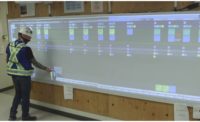Elie H. Homsi will never forget the first day that his brainchild, a pile-driving, girder-launching gantry system, went to work on a $192-million contract to build the Washington Bypass, a six-mile alternative route to Highway 17 in North Carolina. “Next to my children being born, it was the most exciting thing in my life,” says Homsi, since 2003 vice president of engineering services for Flatiron Construction Corp., Longmont, Co.

The pair of 592-ft-long, 750-ton trusses have been placing 120-ft-long segments and pushing out and driving piles as heavy as 40 tons and as deep as 80 ft through sands and clay. The design-build project, held by Flatiron and United Contractors Inc., Chester, S.C., now is 70% complete.
“The system looks easy, and makes you think, ‘why didn’t we come up with this a long time ago?’” says Mark Mallett, Flatiron project manager. “Elie’s our head engineer and that’s the type of leadership we need to think out of the box.”
Homsi drew on his relationship with Italian manufacturer Deal, which “has developed most of my creations,” he says. Ontario-based Berminghammer, a division of Bermingham Foundation Solutions, also helped flesh out Homsi’s idea. Bob French, Flatiron chief operating officer, “was not afraid to take on the implementation,” says Homsi. “It was a huge risk.”
When he first thought of the pile-driving truss, Homsi brought in a group of estimators, foremen, draftsmen and other construction specialists to sit down for two days and evaluate the idea. “I’ve never presented an idea where the initial reaction wasn’t ‘that can’t be done, it’s crazy!’” he says. “That’s what I want. Then I can say, ‘why not’?” The solution, is to tackle problems step by step. “Take 18 bites out of an elephant. You cannot swallow the elephant,” he explains.

Homsi conceived the patent-pending idea of a launching truss that also could drive piles, making it a viable solution for wetlands sites.
Homsi is accustomed to projects that require innovative solutions. He worked on a $21-million subcontract to redesign cast-in-place structures to precast segmental for the Dallas High-Five project. And in 1992, he was involved in switching the erection scheme for Connecticut’s first precast-concrete segmental bridge from a winch-and-beam erection to an overhead launching gantry (ENR 7/27/92 p. 26). With an engineer father and wife, “it’s in the blood,” he says.



Post a comment to this article
Report Abusive Comment